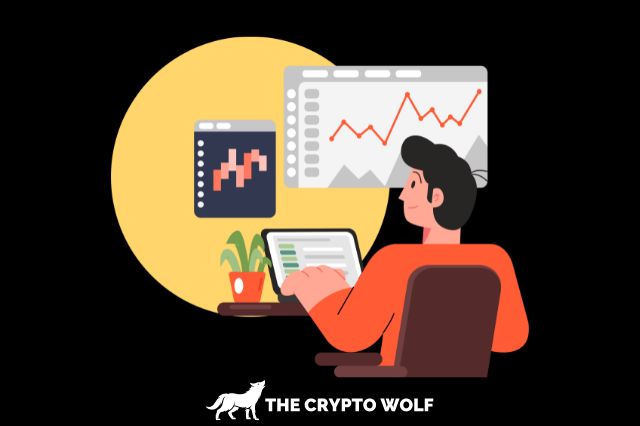In 2019, I opened my first crypto futures position. I was so scared because my trading capital was small, and any loss incurred would multiply due to leverage.
Trading futures is not easy, especially if you lack emotional discipline.
However, if you learn from your mistakes, you will become better at futures trading over time.
I have been trading crypto futures for the past five years. In this article, I will show you how to trade crypto futures and the mistakes to avoid as a beginner.
If you are ready, let’s dive in.
How To Trade Crypto Futures: The Ultimate Guide
1. Get Education

If you’re a beginner in crypto trading, get enough education about futures to avoid losing your funds.
Futures trading is very risky, and the cryptocurrency market is very volatile, which makes it easy to blow your trading account.
As a beginner, focus on education, read books on crypto trading, and sharpen your technical analysis skills to help you make intelligent trading decisions.
It took me three years after I started trading crypto to start futures trading. Currently, I trade only futures, but it took me three years to get here.
2. Understand Key Terms
It’s essential to understand key terms used in the market, such as cross or isolated margin, liquidation, leverage, futures contract, etc.
A Lot of beginners need to learn these terms before jumping into the futures market.
Each of the terms is defined below:
Crypto Futures contract: A crypto futures contract is a financial agreement between two parties to buy or sell a specific amount of a cryptocurrency at a predetermined price on a specified future date.
When you open a futures position for a cryptocurrency, you don’t actually own it; you’ve only entered a contract to buy or sell the cryptocurrency at a future date.
Most crypto exchanges offer two types of futures contracts: perpetual and quarterly.
What Are Perpetual Contracts?
They are crypto futures contracts that don’t have expiration dates.
Perpetual contracts allow you to open a futures contract without worrying about when the trade will be closed or settled against your wish.
What Are Quarterly Contracts?
Just as the name implies, they are contracts that expire every three months.
The day a futures contract expires; the trade is automatically closed or settled, regardless of whether you’re in profit or loss.
Pro tip: I use perpetual contracts for all my trades.
Margin: This is the initial deposit required to open a futures position. It’s a percentage of the contract value that traders must have in their accounts.
Long position: A position in which a trader buys a futures contract with the expectation that the price of the cryptocurrency will rise.
Short Position: A position in which a trader sells a futures contract with the expectation that the price of the cryptocurrency will fall.
Liquidation: When a trader’s position is automatically closed by the exchange due to insufficient margin to cover losses.
Leverage: is the ability to borrow funds from the crypto exchange to increase your trade position.
It allows you to open a large amount of trade with small capital.
Limit Buy Order: If you want to buy a cryptocurrency futures contract at a price lower than the current market price, you can place a limit buy order.
You specify the maximum price you are willing to pay for the contract.
The order will only be executed if the market price reaches or falls below your specified limit price.
Limit Sell Order: if you want to sell a cryptocurrency futures contract at a price higher than the current market price, you can place a limit sell order.
You specify the minimum price you are willing to accept for the contract.
The order will only be executed if the market price reaches or rises above your specified limit price.
Mark price: refers to the price at which a trader enters a position in a futures contract.
It represents the price at which the trader initiates a long (buy) or short (sell) position in the market.
3. Develop A Trading Strategy

It’s the most critical component that will determine if you will make money trading futures or not.
Create one trading strategy and test it for a while to ascertain if it’s profitable or not.
In my crypto trading journey, I have changed my strategy several times when it wasn’t profitable.
Everyone in the market has a unique trading strategy they created based on experience and how good they are with technical analysis.
Some traders only open a position when there’s a breakout of a bullish chart pattern, e.g., the ascending triangle.
Then, some traders only open a position when the cryptocurrency is in accumulation and they spot an RSI divergence.
Irrespective of the trading strategy you chose, remember that the goal is to make profits and minimize loss.
4. Choose Your Preferred Exchange
There are many exchanges that offer futures trading, but if you’re a beginner, I recommend starting with Binance or Kucoin.
If you don’t have an account with any of the above exchanges, then it’s time to create one.
Once the account has been created, you must verify it and then fund it before you can start trading.
Each of the listed platforms is easy to use, and you can start trading futures on Binance the moment your account is verified.
5. Start With Little Capital

Crypto futures trading is risky, and you can lose your money in a flash.
That’s why if you’re a beginner in futures trading, you should start with little capital, something you can afford to lose.
Your goal shouldn’t be to make money immediately but to learn and sharpen your trading instincts.
When I started futures trading, I got liquidated many times before I was able to develop an effective trading strategy.
No matter how good of a trader you are, you need time to understand how the crypto futures market works, which might cause you to lose money in the short run.
Starting with little capital helps you to learn and minimize risks.
6. Practice Risk Management
Risk management is a critical aspect of successful futures trading, as it helps protect your capital and minimize potential losses.
One common risk management technique is to avoid risking more than a certain percentage of your trading capital on a single trade.
Additionally, consider using stop-loss orders to close out losing positions and limit your downside risk.
Position sizing is another important aspect of risk management, as it
determines the amount of capital you allocate to each trade based on your risk tolerance and the size of your trading account.
7. Continuously Learn And Adapt
Finally, remember that trading crypto futures is a journey of continuous learning and adaptation.
Stay informed about the latest developments in the cryptocurrency market,
Hone your trading skills through practice and experience, and be open to refining your strategy as needed.
By staying disciplined, managing your risk effectively, and continuously improving your trading skills,
You can increase your chances of success and thrive in the exciting world of crypto futures trading.
I am still learning, even after trading in the crypto markets for over seven years. You should make continuous learning a part of your trading plan.
Frequently Asked Questions
How Do You Trade Crypto Futures Successfully?
Reduce leverage: Most crypto traders use very high leverage, which makes it easy for them to be liquidated.
A sudden market crash can wipe off their funds.
Set stop loss: If you want to be a successful crypto futures trader, you must set a stop loss immediately after you enter a trade. Remember, a slight loss is better than having your account liquidated.
Never add to a losing position: Most crypto traders make the mistake of adding to a losing position with the hope that it will recover soon and they will be in profit, but that might not happen.
Is Crypto Futures Trading Profitable?
Yes, it is very profitable if you maintain discipline in your trades and develop an effective trading strategy.
Can You Trade Crypto Futures On Binance?
Yes, you can trade crypto futures on Binance and many other exchanges such as Kucoin and by bit.
